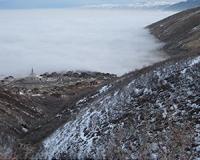 |
Salt Lake City (UPI) Feb 2, 2011 Scientists say a two-month study of winter atmospheric inversions that often choke Salt Lake City in smog will yield valuable data on worldwide air pollution. Part of a study by University of Utah researchers, the work will yield data on how weather conditions create inversions, where warmer air aloft holds cold air near the ground and traps pollutants in urban basins, a university release said Wednesday. "Our study applies to urban basins around the world, any location with a lot of people and mountains nearby," John Horel, a professor of atmospheric sciences, says. "Los Angeles, Phoenix, Tehran and Mexico City experience these winter inversions and cold-air pools," he says. "Unfortunately, one of the advantages of studying them in Salt Lake City is just how frequently they occur here." "We get pretty exhausted launching weather balloons and driving mobile weather stations at all hours of day and night, but it has been a great opportunity to test our understanding of what causes the development and breakup of pollutant-trapping inversions," says graduate student Erik Crosman. Students and volunteers were deployed during intensive observing periods to capture critical data that was combined with continuous automated monitoring of weather conditions around the Salt Lake Valley during the winter. "We're not going to solve the air pollution problem," Horel says. "That may require additional regulation on industry and the public. What we're doing is improving the kinds of information that might eventually be available to decision-makers."
Share This Article With Planet Earth
Related Links The Air We Breathe at TerraDaily.com
 Field Study Of Smoggy Inversions To End
Field Study Of Smoggy Inversions To EndSalt Lake City UT (SPX) Feb 03, 2011 During the past two months, researchers launched weather balloons, drove instrument-laden cars and flew a glider to study winter inversions that often choke Salt Lake City in smog and trap dirty air in other urban basins worldwide. The field campaign - part of a three-year study by the University of Utah and other institutions - ends Monday, Feb. 7 as atmospheric scientists begin analyzing ... read more |
|
| The content herein, unless otherwise known to be public domain, are Copyright 1995-2010 - SpaceDaily. AFP and UPI Wire Stories are copyright Agence France-Presse and United Press International. ESA Portal Reports are copyright European Space Agency. All NASA sourced material is public domain. Additional copyrights may apply in whole or part to other bona fide parties. Advertising does not imply endorsement,agreement or approval of any opinions, statements or information provided by SpaceDaily on any Web page published or hosted by SpaceDaily. Privacy Statement |